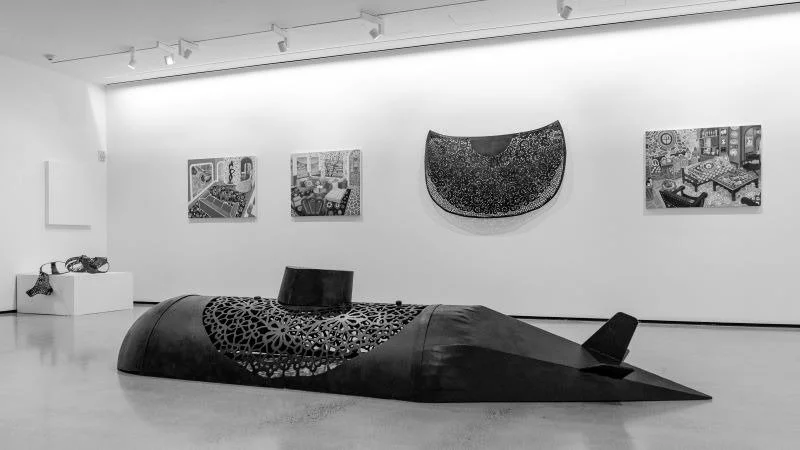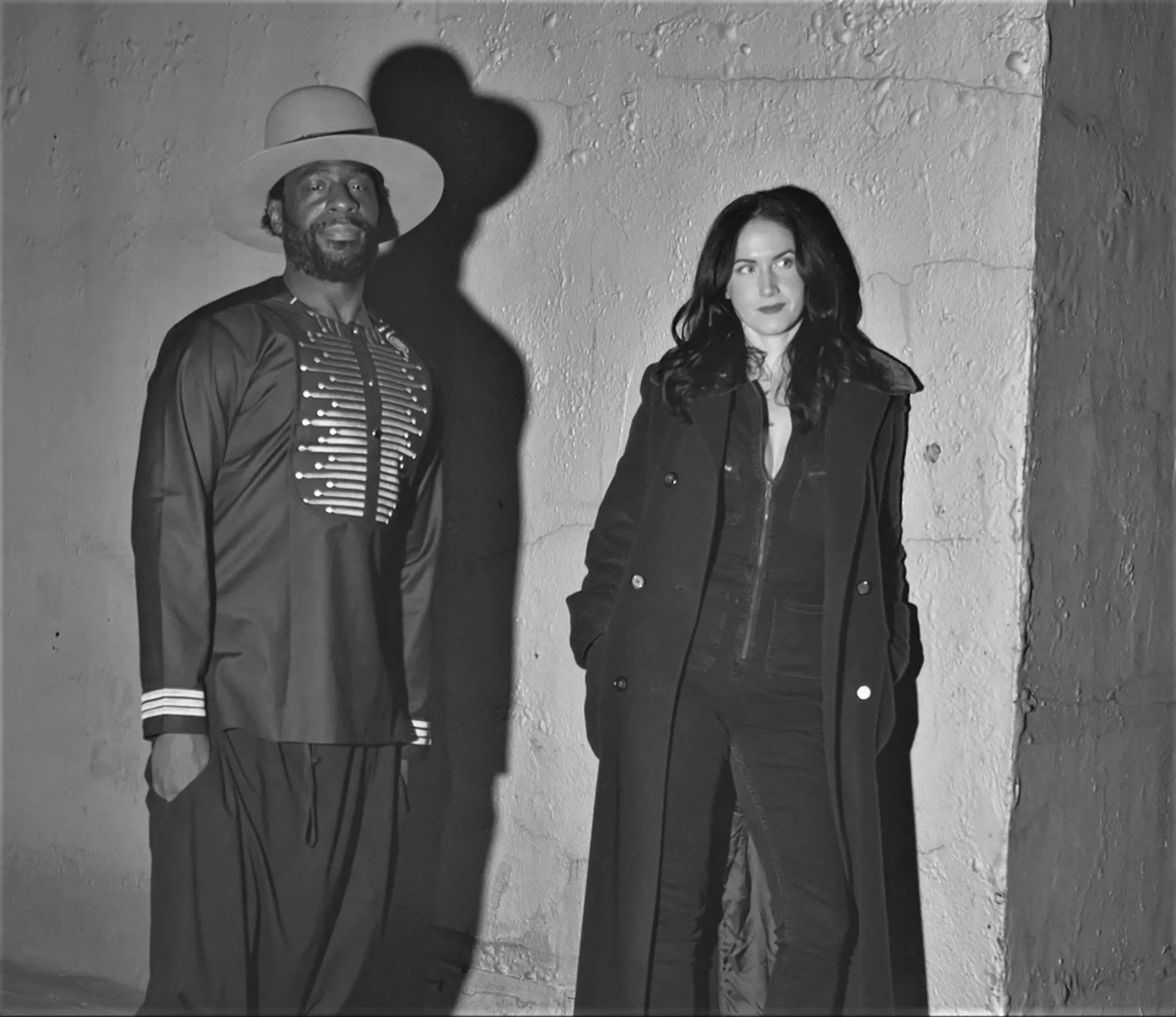The mystical dystopia of FUTURE KULT
FUTURE KULT - Action Wolf Records/AWAL
FUTURE KULT is a new project from Cardiff-based film composer Sion Trefor and Berlin-based musician/art producer Benjamin Zombori. The spark of FUTURE KULT caught on in a remote river valley in Hidalgo, deep in the Mexican countryside. For three months in late 2020, Trefor and Zombori left their lives in Cardiff and Berlin behind and set out to channel the music of a different future. What they created, far off the grid, is the sound of everything, now.
In this interview, Sion and Benjamin talk more about the concepts behind FUTURE KULT and their unique creative approaches to the realization of this intense and evocative project.
Interview by Interlocutor Magazine
Sion and Benjamin, you both traveled to a remote river valley in Hidalgo, Mexico, and stayed there for three months. Did the FUTURE KULT project emerge from this experience unintentionally, or did you travel there specifically in order to seek the right kind of mood/atmosphere to create the dystopian and darkly mystical sounds of FUTURE KULT?
Benjamin: We were definitely looking for a place and a sphere that would allow us to write and record with a fresh perspective. After having worked in the music world for more than a decade now, Sion and I decided to start FUTURE KULT as a band in which we’re completely free as writers, composers, and performers to break into fresh territory. At this point, we need to make music that feels fresh, exciting and relevant to us, and that goal is our main guiding star. I am in Mexico very frequently, and I already knew that the country offers the entire spectrum of human experience and environments, from the very best to the very worst, from the desert to the sprawling megacity.
We knew we were making a record about the here and now, about what it feels like to be human in the 2020s, and Mexico offered the detachment a new environment brings, and also gave us the chance to take a birds-eye view on many of the big subjects that are shaking up the world right now. We entered the writing process openly, and simply tried to stick with what felt exciting and new to us. The mood and atmosphere then grew organically from that, and we feel it reflects many of the uncertainties and the growing alienation in the world right now.
The darkness, the dystopian qualities, I think those are strongly present right now, for anyone willing to see. But I also feel that all is not lost, neither in society nor the art and music it reflects, so there is this hugely interesting sense of duality, which manifests very strongly in Mexico with all its polarization and influenced our focus on the contradictions and complexities of modern life.
What qualities of Hidalgo do you think were essential in formulating the frenetic/unsettled yet also sometimes transcendent vibe of the record? Did the remoteness or some other aspect of the region embody the disconnectedness/disorientation that so much of the world has experienced over the last couple of years due to the lockdowns? What were your day-to-day lives like there?
Benjamin: The remoteness helped us to channel what we intended to do with more clarity, and so did the huge contrasts in daily life we experienced, between genuine rural remoteness, where there’s barely a phone signal or internet, often none at all for days on end, and the endless expanse of the moloch that is Mexico City, an extreme version of urban life. Those two worlds exist in very close proximity in Mexico, and that contrast heightens many of the big issues of our time, from societal polarization to what the lockdowns do with us individually and collectively, the life in an unstable context and the relationship we have with nature, as well as big looming issues like the rise of AI and what role it will play in either assisting or controlling us.
Our days were full with creative experiments, a lot of writing, recording, producing, that’s pretty much all we did, surrounded by the most amazing views of cactuses, arid fields and rugged hills. Sion is by far the most versatile musician I know, he is also an outstanding composer for film and television and a world-class performer, so it was fantastic to have the chance to really explore where our impulses were going to take us. Writing, performing and producing the songs became a completely integrated process. Pretty quickly we felt we hit on a vibe that was more to us than the music itself, we were really guided by the decision to creatively reflect on what we feel is happening in the world on a large scale, and what that does to us as individuals.
The videos for the singles “Hidalgo” and '“Hound in a Storm” are both very striking. First, I want to ask about “Hidalgo,” which has a grainy almost 70s-film look to it and features a sinister singing black-hatted and orange balaclava-wearing figure who seems to be almost like a folk hero or cult figure (people visit shrine-like images of him and get tattoos depicting him), also with hints of unrest and crime (multiple shots of men smashing concrete with sledgehammers).
What were some things you were going for thematically with this video? What were some challenges and surprises of doing a shoot like this in that region?
Benjamin: I mentioned that Sion is a very busy film composer, and I also work as producer in the art world, so visuals are crucial to us and kind of built into our DNA. With our own videos, we aim to create visuals that are not just flickering surfaces, but emotionally charged works of art in their own right. We are deeply involved in the creation of every video, in the case of “Hidalgo” I directed the clip and we produced it together.
We shot in a location very close to where we set up our studio, with the amazing help of many locals from the surrounding villages. Shooting like this is only possible on the basis of genuine respect, and we were humble to see our friends and helpers being excited to get involved. It was essentially a no-budget production, which meant we had to be very resourceful in every respect of planning, shooting and producing the clip, but the stars aligned, the crew were amazing, and now it exists as a work of art that we’re super proud of.
Conceptually we play with the idea of a mythical or real savior figure in an unstable, violent environment, symbolized by the mysterious main character. Rather than resolving it further, we’d love to hear how you and everyone who watches it interprets what you see - that’s where it gets really interesting.
“Hound in a Storm” is more overtly dystopian with its crisp black and white cinematography and its two gas-masked figures immersed in an empty industrial/urban landscape. The video begins with a recording about a mating ritual between birds, and the two figures are clearly engaged in some kind of post-apocalyptic twitchy mating dance/pursuit which I actually found both funny and unsettling.
The gas masks themselves evoke the pandemic, but there is a weird kind of hope at the end as the two figures meet and embrace. Could you talk a little about the concept behind this video? Any particular cinematic influences?
Sion: I know it feels really dystopian on the surface, but for me this is a really elegant, charming depiction of our current reality - you’re totally right, it’s both funny and unsettling at the same time. To my eyes, the video depicts two souls clumsily and curiously forming a new language of connection, intimacy and love during frightening, isolating times. Yeah that could relate to the pandemic, and I get that the gas mask visual is a neat tie-in, but I think it’s much bigger and deeper than that. We’re all fucked in the head, lost, brazen, hopeful, stubborn, simultaneously hyper-connected and disconnected. We try to forge meaning, find love and make purpose, with violently fluctuating results. It’s terrifying and beautiful.
In terms of the conception of the film, I’ve composed for many of [the director] Hardey’s films over the years, he’s a deep thinker and has a great eye. We’re both restless, which I like. He came to me with some rushes of a performance with this gas mask-clad contemporary dancer in an underpass, asked me to score something for it. Towards the tail end of that piece, the score bled into what is now the thumping bass opening of Hound in a Storm. So initially the visuals engendered the music. Then we back-and-forthed on developing the track and contouring the film in parallel, with evolving conversations around what we were interested in expressing. Both track and video emerged in tandem. Rare and luxurious way of doing it, I’d do it like this every time if I could.
You've said “When we started working on this record, we became aware that the world has become too complex to be fully grasped. Surrounded by paranoia, tragedy, extreme tension and fractured hope, we wanted to create music that courses with everything we feel as humans living in the 2020s.” What was it like for the both of you personally to immerse yourselves like this in our terrible zeitgeist? Was it ultimately cathartic, exhausting/depressing, or some combination of these sensations?
Sion: Awesome question. FUTURE KULT is a haven for me. It’s where I can be creatively uninhibited, expressive, on a downer, on a high, where the only opinions and barometers that matter to me are Benji’s and my own. We create it, then we cast it out. It’s a sort of emotional decongestion. It’s cathartic and exciting, but never depressing. Without music, without the only language that can accommodate expressing the cacophony of opposites we experience in our lives - that’s depression. I know I’d be totally screwed without it. I know that looks overblown, melodramatic, if I read it I’d think “ok ok calm down”… but my mental health genuinely relies on my capacity to create music, whoever likes it or even listens. The idea of not having that is terrifying.
Are there plans to do any live performances of this work, and if so, are you considering adding any visual components (video projections, masks, lighting effects, etc.), or what sort of overall atmosphere would like to create during the shows?
Sion: Currently, the plan is to release a lot more music over the course of the year, we’re looking at an EP in late spring, a second full-length album mid-autumn, peppered with singles in between. Right now, I think the focus is on creating more music, but also working with our growing collective of artist and filmmaking collaborators to build a body of great audiovisuals.
In terms of live - possibly somewhere down the line, I’m just not interested in the standard fare. I’ve got no problem with the concert/club circuits, but I’ve been playing them solo and in various outfits since I was a kid. I think this project necessitates something bigger, more unique. I’d like a god damn taiko army, a sax ensemble, an entourage of synths and guitars and percussion. Sure, could be projection, masks, a drone laser show, something with a large dance ensemble would be cool, jousting, free cake, an introduction by Maxine Peake…sky’s the limit. I just think creating and sharing music which piques enough interest to facilitate something on a scale befitting the music is the way forward.
Also check out the FUTURE KULT latest video release: “My Brothers And Me”:
The FUTURE KULT debut album will be released February 25, 2022.
Check out all of our other coverage of innovative musicians and bands








